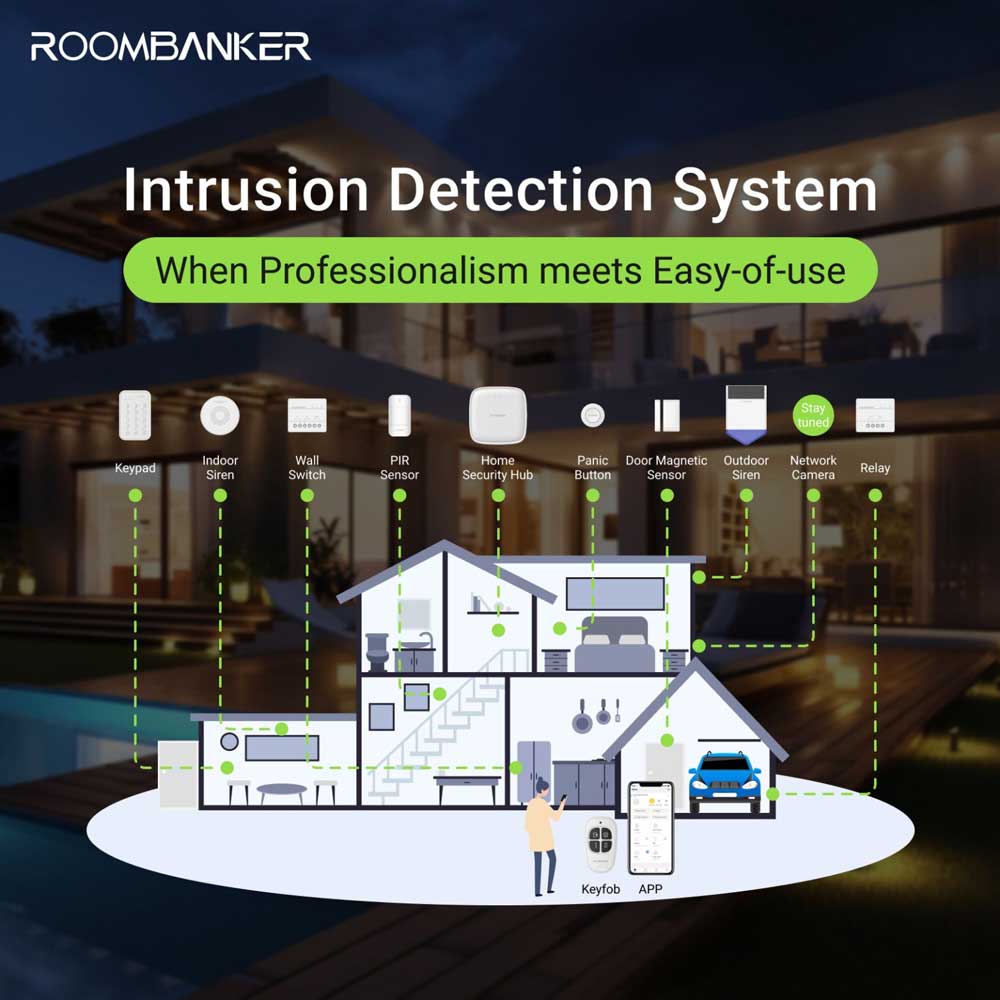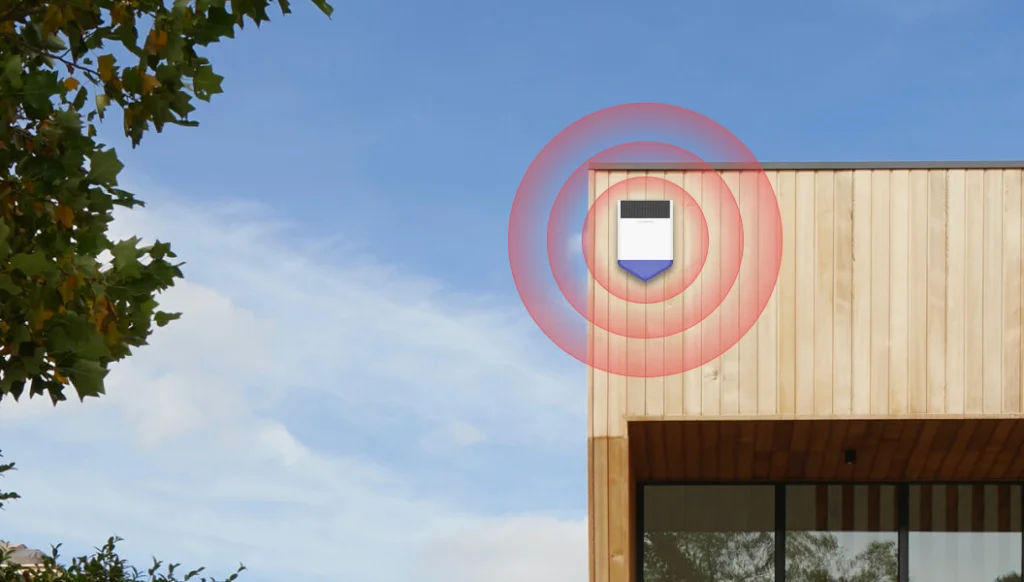PIR sensors are being used in multiple industries, like automated lighting control in home automation. Over time, PIR motion detection technology has evolved in security systems, and leading security system manufacturers are always coming up with new and creative ways to use PIR in alarm systems.
But what is a PIR alarm system? And what makes it different from ordinary systems also using PIR sensors? Let’s find out!
What is a PIR Security System?
PIR alarm systems are usually wireless systems that are installed in areas that are easily broken into and thefts or intruders must have to go across. It can recognize motion from the field of view and activate the home security alarm system. When you have multiple PIR sensors installed in your space, you can see from which room it has detected the motion. It is quite convenient in that way.

Passive infrared (PIR) sensors work by detecting infrared radiation emitted by any object that generates heat. Although this kind of emission is invisible to the human eye, it can be detected by infrared-based sensors.
The PIR sensor in the security alarm system typically detects wavelengths between 8 and 14 um. While human body temperature is between 36 and 37 degrees and emits infrared radiation between 9 to 10 microns, which is precisely inside this range.
PIR Sensors are also frequently called “motion detectors” because they use the movement of infrared wavelengths to identify the presence of individuals.
Since the sensor itself emits no heat or energy, they are known as “passive” sensors. This implies that they are often battery operated, using electricity and energy and the battery lifespan can last for two to three years.
Also read: What is PIR sensor and how does it work?
What are the Main Components of a PIR Alarm System?
The most basic components of a PIR alarm system include the PIR sensor itself, which serves as the primary detection mechanism, a home alarm control panel to process sensor signals and activate alarms, and alarm sirens for scaring away intruders and warning persons within or outside the property.

PIR Sensor
PIR Sensor is mainly used to detect moving human bodies. When we mix the PIR technology in security applications, it becomes a great tool for detecting intruding thieves. After detecting an intrusion, it sends a signal to the smart home security hub, which takes us to our next main component.

Smart Hub/Control Panel
The hub works are the brain of the security system. It performs three main tasks:
- Receive the alarm signal sent by the PIR sensor and process it.
- Send the alarm signal to the cloud server, which in turn will send an alarm message or call notification to the registered home security app.
- Send the alarm command to the alarm sirens to trigger the alarm system. If there are any other controllable devices, such as wall switch, is operated to turn on the lights, they will be controlled at the same time.

Alarm Siren
Alarm siren is used to alert the residents and even neighbors in case any burglar tries to enter your place. You can hang the outdoor sirens around your room, and it will effectively deter possible intruders. It will then trigger the alarm to create a loud noise.

Where Can PIR Sensor-Based Security System Be Used?
To be precise, PIR sensors can be used anywhere security is needed. However, let’s make it concise to three main areas where you can use it.
Houses
Living rooms are the main places for family gatherings, relaxation, and hosting guests. The living rooms are often in close proximity to the property’s entrance, and thus it is often the primary entry point when thieves want to illegally enter the house.
If you own a house or villa, you can use indoor PIR sensors and install them in the living room to detect thieves and trigger the alarm. The PIR sensor will send a notification to your phone via SMS, call and mobile notification, and you can take immediate action to catch the burglar red-handed.
You can also place it in your vault room if you have one to add an extra layer of safety to your valuables.
Houses and villas often have expansive outdoor spaces that serve various purposes such as decoration and recreational activities. Hence, Outdoor PIR sensors, commonly referred to as perimeter defense sensors, prove to be highly advantageous in effective intrusion alarm.

Apartment
Apartments, with large number of residents and frequent visitor turnover, often necessitate centralized property management. For apartment renters, the focus on perimeter defense may not be a top priority. For those who own or rent an apartment, installing the PIR alarm system within your room is a more practical security solution
Since most apartment sizes are compact, a PIR sensor is enough to detect the main entrances and exits in and out of the living room. However, if you have a larger apartment with multiple entry and exit points, you can place a PIR sensor at every point.
The best part is that Roombanker provides no-contract security alarm system and devices, so if you are renting an apartment, you can easily get these PIR sensors without being tied to a long-term contract. By making a one-time purchase, you gain access to the necessary security devices without any additional fees or charges.

Shops
It is also important to keep your store safe when you’re not there to keep an eye on your products. While the PIR sensor may not be very useful during the day when there are a lot of customers entering and exiting your place, it can be a good security tool at night. They will act as your eyes when you’re at home, sleeping peacefully.
PIR sensor is mainly used in shopping areas or warehouse areas to detect illegal intruders. You can turn off the PIR sensors during the day to avoid false alarms and activate it when you leave your shop at night. You can also give activation access to someone trustworthy in your shop so that if you’re not there, they can arm and disarm the retail alarm system.

How to Prevent False Alarms Triggered by Security PIR Sensors?
Frequent entry and exit activity in a location can indeed lead to a higher risk of false alarms with PIR alarm systems. While these systems are generally effective, false alarms can be quite bothersome. To enhance the reliability of your PIR alarm system and minimize false alarms, it is crucial to understand the potential causes and know how to avoid them.
What May Causes False Alarms?
False alarms can be triggered by a variety of factors, often categorized into two main groups: internal device issues and external environmental factors.
False Alarms Caused by Device Failure
Sometimes your device may not be working properly because of issues like damaged sensor components or flaws in the production process. These failures can lead to partial or complete performance breakdown and cause false alarms.
False Alarms Caused by Environmental Changes
- If the sensor is not installed firmly, its detection range and angle may change, and this may cause a false alarm.
- PIR sensors are sensitive to heat changes. Placing the sensor near air conditioning units or ventilation fans may result in temperature fluctuations triggering false alarms. .
- You should also avoid pointing PIR sensors directly toward windows when installing them indoors. This will decrease the likelihood of false alarms brought on by movement outside the window or hot air disturbances.
- Furthermore, if the prevention area are not closed and animals are passing by, it can cause false alarms. So if you have pets, make sure to buy a pet-friendly PIR motion sensor that can withstand your pet’s weight.
What Can Users Do To Reduce the False Alarms?
The activities of animals like dogs and cats should not be detected by an ideal intrusion detector. Additionally, it should also be unresponsive to variations in the indoor climate, including those related to temperature, wind, humidity, rain, and vibration.
However, it’s not that simple because we don’t live in the ideal world. You should install and use PIR sensors as the user manual says and it will help a lot in preventing false alarms.
Here are some of the things you can do to prevent false alarms:
- Proper Installation: Ensure that the sensors are installed at an optimal height of 2.0-2.2 meters above the ground level. This height reduces the likelihood of interference from pets or small objects. It helps the sensors maintain effectiveness in detecting human movement and preventing intrusions.
- Ideal Location: It is better to select installation locations away from sources of rapid temperature changes, such as air conditioners, refrigerators, or stoves. These appliances can trigger false alarms due to fluctuations in air temperature.
- Maintain a Clear Detection Zone: You can keep a clear detection zone around the sensors by avoiding obstructions like screens, furniture, or large plants within its range. These objects can obstruct the sensor’s field of view, leading to inaccurate readings and causing false alarms.
- Avoid Installation Near Windows: Do not install the PIR sensors facing windows to prevent disturbances from external hot air flows or the movement of people outside. If necessary, close curtains to minimize interference.
- Avoid Areas With Strong Air Flow: Lastly, refrain from installing devices in areas with strong airflows, as this can cause motion detection errors. Since the PIR sensors “catch wind” on their radar, it is best to install them in areas with minimum airflow.

Essential PIR Sensor Features to Consider for Ideal Performance
PIR sensor manufacturers are also actively implementing a variety of measures to reduce false alarms. They employ technologies such as digital temperature compensation, independent floating threshold, and anti-white light interference to optimize PIR sensor performance.

- Digital temperature compensation: This technology is utilized to accurately and stably correct the output signal of the detector at different temperatures, enhancing the sensor’s precision and reliability by compensating for temperature variations.
- Independent floating threshold: This adaptive technology allows for the independent adjustment of trigger thresholds for infrared signals, ensuring optimal detection sensitivity in different environmental conditions, time periods or specific areas.
- White light resistance: To counter white light interference, PIR sensors are equipped with specialized filters and algorithms to reduce the impact of visible light on the infrared detectors, as PIR motion detectors primarily target infrared radiation. This technology enables PIR sensors to minimize false alarms.
Take Away
PIR sensors work simultaneously with other security systems to prevent thefts, burglaries, and intrusions. They are a good investment to consider when you’re trying to keep your home or shops safe.
Roombanker offers a wide range of wireless security alarm, home automation, and energy management devices and a mobile app to simplifies home automation and security alarm tasks with user-friendly DIY features.
Whether you’re looking for off-the-shelf products or customized solutions, Roombanker welcomes distributors worldwide as partners. We also provide options for OEM, white label, and ODM solutions, quickly taking your smart home solution to the next level.
So, what are you waiting for? Contact Roombanker today for the best-in-class security devices for your smart solutions.
